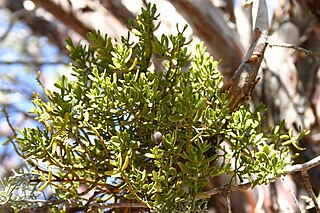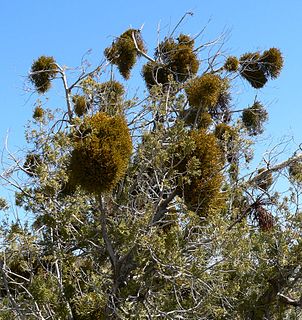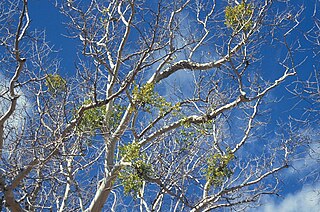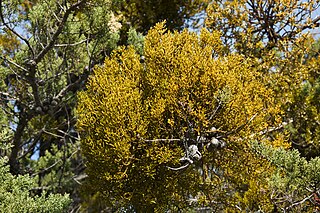
Mistletoe is the common name for obligate hemiparasitic plants in the order Santalales. They are attached to their host tree or shrub by a structure called the haustorium, through which they extract water and nutrients from the host plant.

Senegalia greggii, formerly known as Acacia greggii, is a species of tree in the genus Senegalia native to the southwestern United States and northern Mexico, from the extreme south of Utah south through southern Nevada, southeast California, Arizona, New Mexico and western Texas to Baja California, Sinaloa and Nuevo León in Mexico. The population in Utah at 37°10' N is the northernmost naturally occurring Senegalia species anywhere in the world.

Ilex opaca, the American holly, is a species of holly, native to the eastern and south-central United States, from coastal Massachusetts south to central Florida, and west to southeastern Missouri and eastern Texas.

A conifer cone is an organ on plants in the division Pinophyta (conifers) that contains the reproductive structures. The familiar woody cone is the female cone, which produces seeds. The male cone, which produces pollen, is usually herbaceous and much less conspicuous even at full maturity. The name "cone" derives from Greek konos (pinecone), which also gave name to the geometric cone. The individual plates of a cone are known as scales. The umbo of a conifer cone refers to the first year's growth of a seed scale on the cone, showing up as a protuberance at the end of the two-year-old scale.

Ulmus crassifoliaNutt., the Texas cedar elm or simply cedar elm, is a deciduous tree native to south central North America, mainly in southern and eastern Texas, southern Oklahoma, Arkansas and Louisiana, with small populations in western Mississippi, southwest Tennessee and north central Florida; it also occurs in northeastern Mexico. It is the most common elm tree in Texas. The tree typically grows well in flat valley bottom areas referred to as 'Cedar Elm Flats'. The common name 'cedar elm' is derived from the trees' association with juniper trees, locally known as cedars.

Calocedrus decurrens, with the common names incense cedar and California incense-cedar, is a species of conifer native to western North America. It is the most widely known species in the genus, and is often simply called 'incense cedar' without the regional qualifier.

Viscum album is a species of mistletoe in the family Santalaceae, commonly known as European mistletoe, common mistletoe or simply as mistletoe. It is native to Europe and western and southern Asia.

Phoradendron is a genus of mistletoe, native to warm temperate and tropical regions of the Americas. The center of diversity is the Amazon rainforest. Phoradendron is the largest genus of mistletoe in the Americas, and possibly the largest genus of mistletoes in the world. Traditionally, the genus has been placed in the family Viscaceae, but recent genetic research acknowledged by the Angiosperm Phylogeny Group shows this family to be correctly placed within a larger circumscription of the sandalwood family, Santalaceae.

Phoradendron leucarpum is a species of mistletoe in the Viscaceae family which is native to the United States and Mexico. Its common names include American mistletoe, eastern mistletoe, hairy mistletoe and oak mistletoe. It is native to Mexico and the continental United States. It is hemiparasitic, living in the branches of trees. The berries are white and 3–6 millimeters (0.12–0.24 in). It has opposite leaves that are leathery and thick. Ingesting the berries can cause "stomach and intestinal irritation with diarrhea, lowered blood pressure, and slow pulse". This shrub can grow to 1 meter (3.3 ft) by 1 meter (3.3 ft).

Phoradendron californicum, the desert mistletoe or mesquite mistletoe, is a hemiparasitic plant native to southern California, Nevada, Arizona, Sonora, Sinaloa and Baja California. It can be found in the Mojave and Sonoran Deserts at elevations of up to 1400 m.

Phoradendron densum Trel. is a species of flowering plant in the sandalwood family known by the common name dense mistletoe. It is native to the western United States and northwestern Mexico, where it grows in various types of woodland habitat. It has been reported from California, Oregon, Arizona and Baja California. This mistletoe parasitizes species of cypress, including Arizona cypress, and juniper.

Phoradendron juniperinum is a species of flowering plant in the sandalwood family known by the common name juniper mistletoe. It is native to the southwestern United States and northern Mexico, where it grows in various types of woodland habitat. It has been reported from California, Nevada, Arizona, New Mexico, Oregon, Utah, Texas, Chihuahua and Sonora.

Phoradendron macrophyllum is a species of flowering plant in the sandalwood family known by the common names Colorado Desert mistletoe, bigleaf mistletoe, and Christmas mistletoe. It is native to western United States and northern Mexico from Oregon to Colorado to Texas to Baja California, where it grows in many types of wooded habitat at elevations up to 1700 m.

Phoradendron pauciflorum is a species of flowering plant in the sandalwood family known by the common name fir mistletoe. It is native to coniferous forests in California, Arizona, and Baja California.

Phoradendron villosum is a species of flowering plant in the sandalwood family known by the common names Pacific mistletoe and oak mistletoe. It is native to western North America from Oregon south into Mexico, where it grows in oak woodland and similar habitat.

Pistacia atlantica is a species of pistachio tree known by the English common name Mt. Atlas mastic tree, Cyprus turpentine tree, and the Persian turpentine tree. Pistacia ranges from shrubs to trees adapted to drought and the Mediterranean climate. P. atlantica has three subspecies or varieties which have been described as cabulica, kurdica, and mutica.

Phoradendron tomentosum, the leafy mistletoe, hairy mistletoe or Christmas mistletoe, is a plant parasite. It is characterized by its larger leaves and smaller berries than dwarf mistletoe. Leafy mistletoe seldom kill but they do rob their hosts of moisture and some minerals, causing stress during drought and reducing crop productions on fruit and nut trees. Leafy mistletoe has the ability to photosynthesize on its own but it relies on other plants in order to obtain its nutrients. It attaches itself to a tree and then grows haustoria, in order to get the food and water it needs.
Phoradendron coryae, Cory's mistletoe or oak mistletoe, is a hemiparasitic plant native to the southwestern United States and northern Mexico. It is reported from Arizona, New Mexico, Texas, Chihuahua, Coahuila and Sonora.

Phoradendron bolleanum, commonly called Bollean mistletoe, is a species of plant in the sandalwood family that is native to the desert southwest, California and southern Oregon in the United States.

Peraxilla colensoi, the scarlet mistletoe, is a shrubby parasitic plant composed of broad, leathery leaves that grow up to 8 cm long and have a red edge. The common name is derived from the scarlet petals of the plant that bloom every October to January. These mistletoes are parasitic plants whose seeds attach themselves to host plants. The most common host for these plants is the silver beech. The plant can grow up to 3 meters tall and are often located in low altitudes throughout the North and South Islands of New Zealand.

















